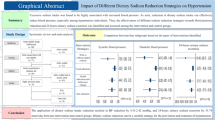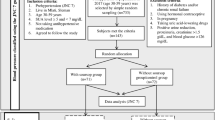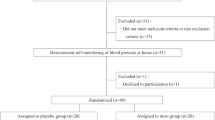Abstract
To clarify the dose-response and the time-response relationship between liquorice consumption and rise in blood pressure and explore the inter-individual variance this intervention study was designed and executed in research laboratories at University hospitals in Iceland and Sweden. Healthy, Caucasian volunteers who also served as a control for himself/herself consumed liquorice in various doses, 50–200 g/day, for 2–4 weeks, corresponding to a daily intake of 75–540 mg glycyrrhetinic acid, the active substance in liquorice. Blood pressure was measured before, during and after liquorice consumption. Systolic blood pressure increased by 3.1–14.4 mm Hg (P < 0.05 for all), demonstrating a dose-response but not a time-response relationship. The individual response to liquorice followed the normal distribution. Since liquorice raised the blood pressure with a linear dose-response relationship, even doses as low as 50 g of liquorice (75 mg glycyrrhetinic acid) consumed daily for 2 weeks can cause a significant rise in blood pressure. The finding of a maximal effect of liquorice after only 2 weeks has important implications for all doctors dealing with hypertension. There does not seem to be a special group of responders since the degree of individual response to liquorice consumption followed the normal distribution curve.
This is a preview of subscription content, access via your institution
Access options
Subscribe to this journal
Receive 12 digital issues and online access to articles
$119.00 per year
only $9.92 per issue
Buy this article
- Purchase on Springer Link
- Instant access to full article PDF
Prices may be subject to local taxes which are calculated during checkout
Similar content being viewed by others
References
Lucas R Nature's Medicines (the folklore, romance, and value of herbal remedies). Awards books, A916N. 1976: New York (Universal-Award House, c1966) pp 89–94
Blachley JD, Knochel JP Tobacco chewer’s hypokalemia: licorice revisited N Engl J Med 1980 302 784–785
Sigurjonsdottir HA, Ragnarsson J Hathrystingur af völdum lakkriss Laeknabladid/The Icelandic Med J 1993 79 87–91
Folkerssen L, Knudsen NA-L, Teglbjaerg PS Licorice. A basis for precautions one more time Ugeskr Laeger 1996 158 7420–7421
van der Zwan A Hypertension encephalopathy after liquorice ingestion Clin Neurol Neurosurg 1993 95 35–37
de Klerk GJ, Nieuwenhuis MG, Beutler JJ Hypokalaemia and hypertension associated with use of liquorice flavoured chewing gum BMJ 1997 314 731–2
Dellow EL, Unwin RJ, Honour JW Pontefract cakes can be bad for you: refractory hypertension and liquorice excess Nephrol Dial Transplant 1999 14 218–220
Sigurjonsdottir HA et alIs blood pressure commonly raised by moderate consumption of liquorice? J Hum Hypertens 1995 9 345–348
van Uum SHM et alThe role of 11 beta-hydroxysteroid dehydrogenase in the pathogenesis of hypertension Cardiovasc Res 1998 38 16–24
Walker BR, Edwards CRW Licorice-induced hypertension and syndromes of apparent mineralocorticoid excess Endocrinol Metab Clin North Am 1994 23 359–377
Farese Jr RV et alLicorice induced hypermineralcorticoidism N Engl J Med 1991 325 1223–1227
Störmer FC, Reistad R, Alexander J Glycyrrhizic acid in liquorice – evaluation of health hazard Food Chem Toxicol 1993 31 303–312
Palermo M et alUrinary free cortisone and the assessment of 11 beta-hydroxysteroid dehydrogenase activity in man Clin Endocrinol (Oxf) 1996 45 605–611
Epstein MT et alLiquorice toxicity and the renin-angiotensin-aldosterone axis in man BMJ 1977 1 209–210
Hollifield JW Clinical significance of plasma renin activity J Tenn Med Ass 1973 66 947–948
Megia A et alAngiotensin I-converting enzyme levels and renin-aldosterone axis recovery after cessation of chronic licorice ingestion Nephron 1993 65 329–330
Acknowledgements
We thank Mr O Petursson, the Drift liquorice sweet factory in Iceland and the Malaco sweet factory in Sweden for kindly supplying all liquorice, and to Sverker Jern head of the Clinical Experimental Laboratory, Sahlgrenska University Hospital/Östra for constructive discussion and statistical help. This study was supported by a grant from the Science Fund of the Reykjavik City Hospital and The Göteborg Medical Society. (Competing interests: None declared.)
Author information
Authors and Affiliations
Rights and permissions
About this article
Cite this article
Sigurjónsdóttir, H., Franzson, L., Manhem, K. et al. Liquorice-induced rise in blood pressure: a linear dose-response relationship. J Hum Hypertens 15, 549–552 (2001). https://doi.org/10.1038/sj.jhh.1001215
Received:
Revised:
Accepted:
Published:
Issue Date:
DOI: https://doi.org/10.1038/sj.jhh.1001215
Keywords
This article is cited by
-
Blutdruckexazerbation durch zu viel Lakritz
CardioVasc (2024)
-
A fistful of candies for hypertension
Internal and Emergency Medicine (2023)
-
Glycyrrhizin-Induced Pseudohyperaldosteronism: A Case Report
Chinese Journal of Integrative Medicine (2022)
-
A life-threatening case of pseudo-aldosteronism secondary to excessive liquorice ingestion
BMC Endocrine Disorders (2021)
-
Food Products That May Cause an Increase in Blood Pressure
Current Hypertension Reports (2020)



